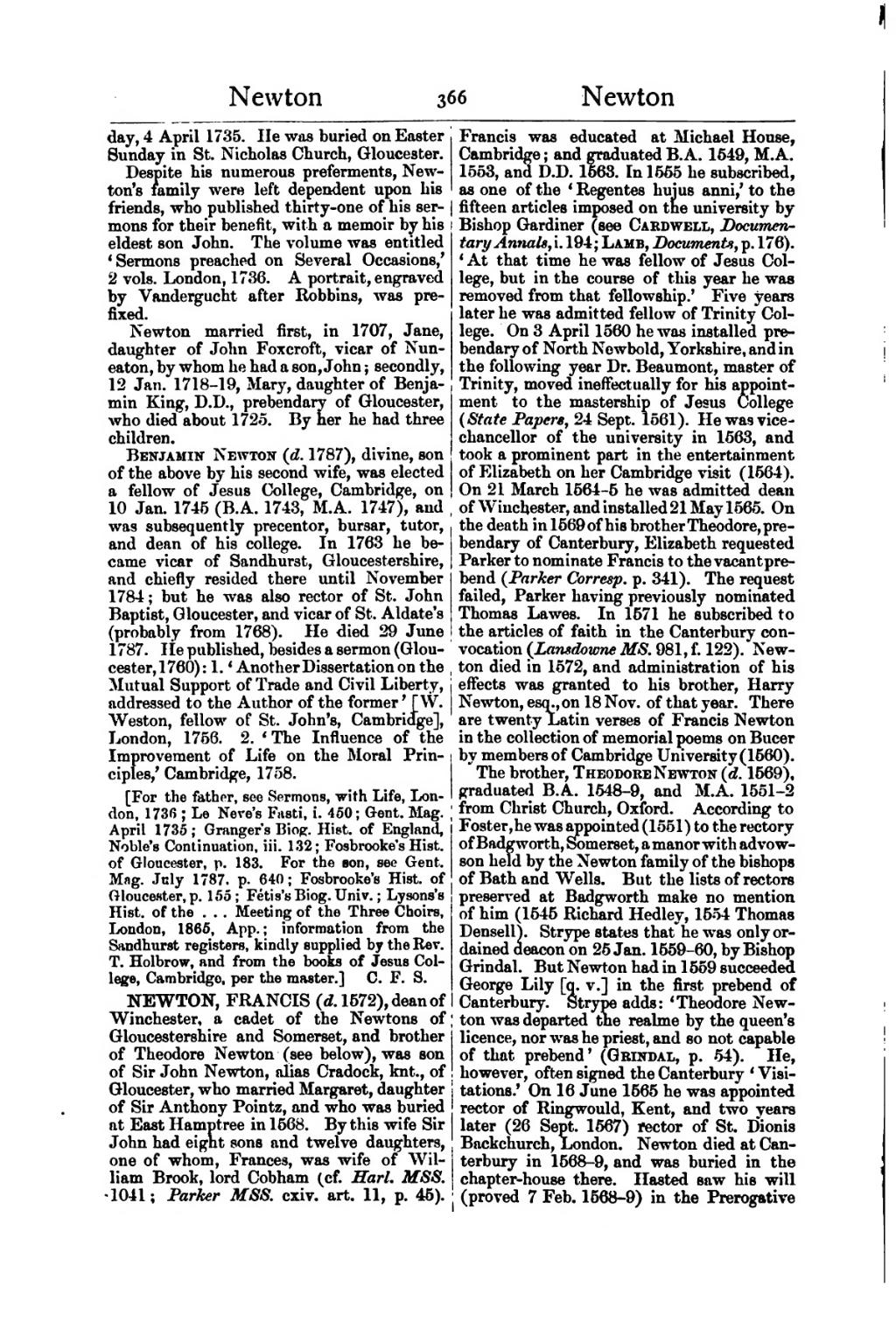day, 4 April 1735. He was buried on Easter Sunday in St. Nicholas Church, Gloucester.
Despite his numerous preferments, Newton's family were left dependent upon his friends, who published thirty-one of his sermons for their benefit, with a memoir by his eldest son John. The volume was entitled ‘Sermons preached on Several Occasions,’ 2 vols. London, 1736. A portrait, engraved by Vandergucht after Robbins, was prefixed.
Newton married first, in 1707, Jane, daughter of John Foxcroft, vicar of Nuneaton, by whom he had a son, John; secondly, 12 Jan. 1718–19, Mary, daughter of Benjamin King, D.D., prebendary of Gloucester, who died about 1725. By her he had three children.
Benjamin Newton (d. 1787), divine, son of the above by his second wife, was elected a fellow of Jesus College, Cambridge, on 10 Jan. 1745 (B.A. 1743, M.A. 1747), and was subsequently precentor, bursar, tutor, and dean of his college. In 1763 he became vicar of Sandhurst, Gloucestershire, and chiefly resided there until November 1784; but he was also rector of St. John Baptist, Gloucester, and vicar of St. Aldate's (probably from 1768). He died 29 June 1787. He published, besides a sermon (Gloucester, 1760): 1. ‘Another Dissertation on the Mutual Support of Trade and Civil Liberty, addressed to the Author of the former’ [W. Weston, fellow of St. John's, Cambridge], London, 1756. 2. ‘The Influence of the Improvement of Life on the Moral Principles,’ Cambridge, 1758.
[For the father, see Sermons, with Life, London, 1736; Le Neve's Fasti, i. 450; Gent. Mag. April 1735; Granger's Biog. Hist. of England, Noble's Continuation, iii. 132; Fosbrooke's Hist. of Gloucester, p. 183. For the son, see Gent. Mag. July 1787, p. 640; Fosbrooke's Hist. of Gloucester, p. 155; Fétis's Biog. Univ.; Lysons's Hist. of the … Meeting of the Three Choirs, London, 1865, App.; information from the Sandhurst registers, kindly supplied by the Rev. T. Holbrow, and from the books of Jesus College, Cambridge, per the master.]
NEWTON, FRANCIS (d. 1572), dean of Winchester, a cadet of the Newtons of Gloucestershire and Somerset, and brother of Theodore Newton (see below), was son of Sir John Newton, alias Cradock, knt., of Gloucester, who married Margaret, daughter of Sir Anthony Pointz, and who was buried at East Hamptree in 1568. By this wife Sir John had eight sons and twelve daughters, one of whom, Frances, was wife of William Brook, lord Cobham (cf. Harl. MSS. 1041; Parker MSS. cxiv. art 11, p. 45). Francis was educated at Michael House, Cambridge; and graduated B.A. 1549, M.A. 1553, and D.D. 1563. In 1555 he subscribed, as one of the ‘Regentes hujus anni,’ to the fifteen articles imposed on the university by Bishop Gardiner (see Cardwell, Documentary Annals, i. 194; Lamb, Documents, p. 176). ‘At that time he was fellow of Jesus College, but in the course of this year he was removed from that fellowship.’ Five years later he was admitted fellow of Trinity College. On 3 April 1560 he was installed prebendary of North Newbald, Yorkshire, and in the following year Dr. Beaumont, master of Trinity, moved ineffectually for his appointment to the mastership of Jesus College (State Papers, 24 Sept. 1561). He was vice-chancellor of the university in 1563, and took a prominent part in the entertainment of Elizabeth on her Cambridge visit (1564). On 21 March 1564–5 he was admitted dean of Winchester, and installed 21 May 1565. On the death in 1569 of his brother Theodore, prebendary of Canterbury, Elizabeth requested Parker to nominate Francis to the vacant prebend (Parker Corresp. p. 341). The request failed, Parker having previously nominated Thomas Lawes. In 1571 he subscribed to the articles of faith in the Canterbury convocation (Lansdowne MS. 981, f. 122). Newton died in 1572, and administration of his effects was granted to his brother, Harry Newton, esq., on 18 Nov. of that year. There are twenty Latin verses of Francis Newton in the collection of memorial poems on Bucer by members of Cambridge University (1560).
The brother, Theodore Newton (d. 1569), graduated B.A. 1548–9, and M.A. 1551–2 from Christ Church, Oxford. According to Foster, he was appointed (1551) to the rectory of Badgworth, Somerset, a manor with advowson held by the Newton family of the bishops of Bath and Wells. But the lists of rectors preserved at Badgworth make no mention of him (1545 Richard Hedley, 1554 Thomas Densell). Strype states that he was only ordained deacon on 25 Jan. 1559–60, by Bishop Grindal. But Newton had in 1559 succeeded George Lily [q. v.] in the first prebend of Canterbury. Strype adds: ‘Theodore Newton was departed the realme by the queen's licence, nor was he priest, and so not capable of that prebend’ (Grindal, p. 54). He, however, often signed the Canterbury ‘Visitations.’ On 16 June 1565 he was appointed rector of Ringwould, Kent, and two years later (26 Sept. 1567) rector of St. Dionis Backchurch, London. Newton died at Canterbury in 1568–9, and was buried in the chapter-house there. Hasted saw his will (proved 7 Feb. 1568–9) in the Prerogative

